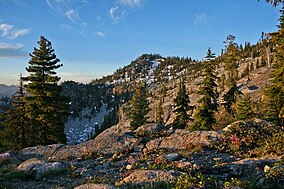Marble Mountain Wilderness
| Marble Mountain Wilderness | |
|---|---|
|
IUCN category Ib (wilderness area)
|
|

English Peak in the wilderness
|
|
| Location | Klamath National Forest, Siskiyou County, northern California |
| Nearest city | Yreka, California |
| Coordinates | 41°29′24″N 123°13′30″W / 41.4901317°N 123.2250481°WCoordinates: 41°29′24″N 123°13′30″W / 41.4901317°N 123.2250481°W |
| Area | 241,744 acres (978.30 km2) |
| Established | 1964 |
| Governing body | U.S. Forest Service |
The Marble Mountain Wilderness is a 241,744-acre (978.30 km2)wilderness area located 60 miles (97 km) southwest of Yreka, California, in the United States. It is managed by the U.S. Forest Service and is within the Klamath National Forest in Siskiyou County. The land was first set aside on April 1931 as the Marble Mountain Primitive Area, which comprised 234,957 acres (950.84 km2). It was one of four areas to gain primitive status under the Forest Service's L-20 regulations that year. In 1964, it became a federally designated wilderness area when the U.S. Congress passed the Wilderness Act.
The name comes from the distinctive coloration caused by light-colored limestone along with black metamorphic rock on some peaks, giving the mountains a marbled appearance. There are at least five different rock types identified here. The wilderness is in the Klamath Mountains geomorphic province (a large area having similar features such as terrain and geology). The horseshoe-shaped Salmon Mountains are at the core of the wilderness with Marble Mountain being a north-trending spur ridge of the Salmons. The highest point in the Marbles is Boulder Peak at 8,299 feet (2,530 m).
This area of high divides, deep canyons and perennial mountain streams provides habitat for a wide variety of plant and animal life. With more than 7,000 feet (2,100 m) of vertical relief, soils from several rock types, and abundant rain and snowfall, the diversity of ecosystems is unequaled anywhere else in the country.
The wilderness contains a number of isolated stands of locally rare conifers. For example, the subalpine fir grows along the granite moraines at the head of watersheds above 6,000 feet (1,800 m) in open areas surrounding lakes and meadows, in the Sky High Lakes Basin, in Shelly Meadow along the Pacific Crest Trail and in the Deep Lake area. All of the subalpine fir groves in northwest California are more than 50 miles (80 km) from the next closest subalpine fir stand, which is in southern Oregon on Mount Ashland. In addition, the headwaters of the Salmon River in the wilderness also hold a relict stand of Pacific silver fir, which is the southern most stand in the range of the species.
...
Wikipedia

